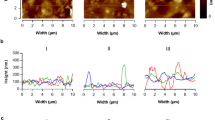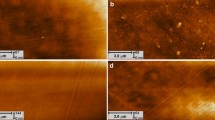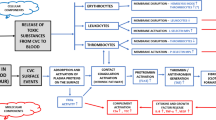Abstract
The use of intravascular catheters is frequently associated with coag ulase-negative staphylococcal infections. Colonization of catheters depends on the ability of bacteria to attach to artificial surfaces, this process is affected by macromolecules present in the body fluids. We determined the adherence of five coagulase-negative strains onto polyethylene, nylon and polyvinyl-chloride catheters, after treatment of bacteria, catheters or both with citrated human plasma, human serum albumin or fibrinogen. Plasma and serum albumin produced a marked inhibition of bacterial adherence (P < 0.05) by means of adsorption on biomaterial surface. Fibrinogen enhanced (P < 0.05) the number of bound bacteria, specially through its interaction with the staphylococcal surface. These observations suggest the possible role of plasma proteins in these infections.
Similar content being viewed by others
References
Absolom DR (1988) The role of bacterial hydrophobicity in infection: bacterial adhesion and phagocytic ingestion. Can J Microbiol 34:287–298
Baier RE (1983) Surface chemical factors presaging bioadhesive events. Ann NY Acad Sci 34–57
Baird-Parker AC (1990) The staphylococci: an introduction. J Appl Bacteriol Symp [Suppl]:15–85
Brash JL, ten Hove P (1989) Transient adsorption of fibrinogen on foreign surfaces: Similar behavior in plasma and whole blood. J Biomed Mater Res 23:157–169
Brash JL, Scott CF, ten Hove P, Wojciechowski P, Colman RW (1988) Mechanism of transient adsorption of fibrinogen from plasma to solid surfaces: role of the contact and fibrinolytic systems. Blood 71:932–939
Christensen GD, Simpson WA, Bisno AL, Beachey EH (1982) Adherence of slime-producing strains of Staphylococcus epidermis to smooth surfaces. Infect Immun 37:318–326
Dickinson GM, Bisno AL (1989) Infections associated with indwelling devices: concepts of pathogenesis; infections associated with intravascular devices. Antimicrob Agents Chemother 33:597–601
Duguid JP (1951) The demonstration of bacterial capsules and slime. J Pathol Bacteriol 63:673–685
Ferreirós CM, Carballo J, Criado MT, Sáinz V, de Rio MC (1989) Surface free energy and interaction of Staphylococcus epidermis with biomaterials. FEMS Microbiol Lett 60:89–94
Fletcher M (1976) The effects of proteins on bacterial attachment to polystyrene. J Gen Microbiol 94:400–404
Gibbons JD (1976) Inferences concerning location based on two or more samples. In: Gibbons JD (ed) Non-parametric methods for quantitative analysis. Holt, Rinehart & Winston, New York, pp 157–204
Herrmann M, Vaudaux PE, Pittet D, Auckenthaler R, Lew PD, Schumacher-Perdreau F, Peters G, Waldvogel FA (1988) Fibronectin, fibrinogen and laminin act as mediators of adherence of clinical staphylococcal isolates to foreign material. J Infect Dis 158:693–701
Hogh AH, Dankert J, Feijen J (1983) Adhesion of coagulase-negative staphylococci to biomaterials. J Gen Microbiol 129:2959–2968
Hogh AH, Dankert J, Feijen J (1985) Adhesion of Staphylococcus epidermis and Staphylococcus saprophyticcus to a hydrophobic material. J Gen Microbiol 131:2485–2491
Kloos WE, Schleifer KH (1975) Simplified scheme for routine identification of human Staphylococcus species. J Clin Microbiol 1:82–88
Lämmler C, Schaufuß P, Frede C, Blobel H (1988) Bindings of plasma proteins to streptococci of serological group L with special reference to their immunoglobulin G Fc-receptor activity. Can J Microbiol 34:1–5
Ludwicka A, Locci R, Jansen B, Peters G, Pulverer G (1983) Microbial colonization of prosthetic devices. V. Attachment of coagulase-negative staphylococci and “slime”-production on chemically pure synthetic polymers. Zentral Bacteriol Hyg Mikrobiol [B] 177:527–532
Mohammad SF, Topham NS, Burns GL, Olsen DB (1988) Enhanced bacterial adhesion on surfaces pretreated with fibrinogen and fibronectin. Trans Am Soc Artif Intern Organs 34:573–577
Pascual A, Fleer A, Westerdaal NAC, Verhoef J (1986) Modulation of adherence of coagulasenegative staphylococci to Teflon catheters in vitro. Eur J Clin Microbiol 5:518–522
Pedersen K (1981) Electrostatic interaction chromathography, a method for assaying the relative surface charge of bacteria. FEMS Microbiol Lett 12:365–367
Pringle JH, Fletcher M (1986) Influence of substratum hydration and adsorbed macromolecules on bacterial attachment to surfaces. Appl Environ Microbiol 51:1321–1325
Rosenberg M, Gutnick D, Rosenberg E (1980) Adherence of bacteria to hydrocarbons: a simple method for measuring cell-surface hydrophobicity. FEMS Microbiol Lett 9:29–33
Rutter PR, Vincent B (1980) The adhesion of microorganisms to surfaces: physicochemical aspects. In: Berkeley CRM, Lynch JM, Melling J, Rutter PR, Vincent B (eds) Microbial adhesion to surfaces. Ellis Horwood, Chichester, pp 79–90
Vaudaux P, Pittet D, Haeberli A, Huggler E, Nydegger UE, Lew DP, Waldvogel FA (1989) Host factors selectively increase staphylococcal adherence on inserted catheters: a role for fibronectin and fibrinogen or fibrin. J Infect Dis 160:865–875
Author information
Authors and Affiliations
Rights and permissions
About this article
Cite this article
Carballo, J., Ferreirós, C.M. & Criado, M.T. Importance of experimental design in the evaluation of the influence of proteins in bacterial adherence to polymers. Med Microbiol Immunol 180, 149–155 (1991). https://doi.org/10.1007/BF00206119
Received:
Issue Date:
DOI: https://doi.org/10.1007/BF00206119




